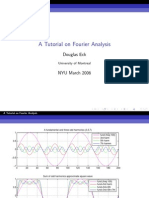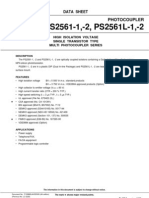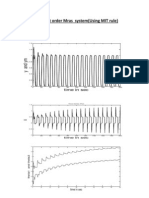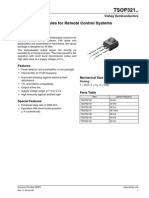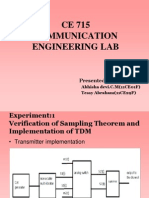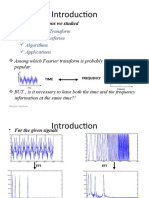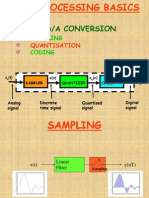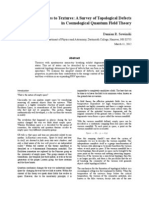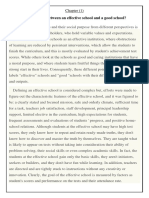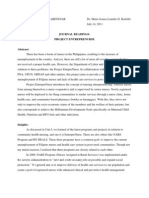Fourier Theory Made Easy (?)
Fourier Theory Made Easy (?)
Uploaded by
gaurav_juneja_4Copyright:
Available Formats
Fourier Theory Made Easy (?)
Fourier Theory Made Easy (?)
Uploaded by
gaurav_juneja_4Original Description:
Original Title
Copyright
Available Formats
Share this document
Did you find this document useful?
Is this content inappropriate?
Copyright:
Available Formats
Fourier Theory Made Easy (?)
Fourier Theory Made Easy (?)
Uploaded by
gaurav_juneja_4Copyright:
Available Formats
Fourier theory made easy (?
)
0 0.1 0.2 0.3 0.4 0.5 0.6 0.7 0.8 0.9 1
-8
-6
-4
-2
0
2
4
6
8
5*sin (2t4t)
Amplitude = 5
Frequency = 4 Hz
seconds
A sine wave
0 0.1 0.2 0.3 0.4 0.5 0.6 0.7 0.8 0.9 1
-8
-6
-4
-2
0
2
4
6
8
5*sin(2t4t)
Amplitude = 5
Frequency = 4 Hz
Sampling rate = 256
samples/second
seconds
Sampling duration =
1 second
A sine wave signal
0 0.2 0.4 0.6 0.8 1 1.2 1.4 1.6 1.8 2
-2
-1.5
-1
-0.5
0
0.5
1
1.5
2
sin(2t8t), SR = 8.5 Hz
An undersampled signal
The Nyquist Frequency
The Nyquist frequency is equal to one-half
of the sampling frequency.
The Nyquist frequency is the highest
frequency that can be measured in a signal.
http://www.falstad.com/fourier/j2/
Fourier series
Periodic functions and signals may be
expanded into a series of sine and cosine
functions
The Fourier Transform
A transform takes one function (or signal)
and turns it into another function (or signal)
The Fourier Transform
A transform takes one function (or signal)
and turns it into another function (or signal)
Continuous Fourier Transform:
close your eyes if you
dont like integrals
The Fourier Transform
A transform takes one function (or signal)
and turns it into another function (or signal)
Continuous Fourier Transform:
( ) ( )
( ) ( )
}
}
=
=
df e f H t h
dt e t h f H
ift
ift
t
t
2
2
A transform takes one function (or signal)
and turns it into another function (or signal)
The Discrete Fourier Transform:
The Fourier Transform
=
=
=
1
0
2
1
0
2
1
N
n
N ikn
n k
N
k
N ikn
k n
e H
N
h
e h H
t
t
Fast Fourier Transform
The Fast Fourier Transform (FFT) is a very
efficient algorithm for performing a discrete
Fourier transform
FFT principle first used by Gauss in 18??
FFT algorithm published by Cooley & Tukey in
1965
In 1969, the 2048 point analysis of a seismic trace
took 13 hours. Using the FFT, the same task on
the same machine took 2.4 seconds!
0 0.2 0.4 0.6 0.8 1 1.2 1.4 1.6 1.8 2
-2
-1
0
1
2
0 20 40 60 80 100 120
0
50
100
150
200
250
300
Famous Fourier Transforms
Sine wave
Delta function
Famous Fourier Transforms
0 5 10 15 20 25 30 35 40 45 50
0
0.1
0.2
0.3
0.4
0.5
0 50 100 150 200 250
0
1
2
3
4
5
6
Gaussian
Gaussian
Famous Fourier Transforms
-1 -0.8 -0.6 -0.4 -0.2 0 0.2 0.4 0.6 0.8 1
-0.5
0
0.5
1
1.5
-100 -50 0 50 100
0
1
2
3
4
5
6
Sinc function
Square wave
Famous Fourier Transforms
Sinc function
Square wave
-1 -0.8 -0.6 -0.4 -0.2 0 0.2 0.4 0.6 0.8 1
-0.5
0
0.5
1
1.5
-100 -50 0 50 100
0
1
2
3
4
5
6
Famous Fourier Transforms
Exponential
Lorentzian
0 50 100 150 200 250
0
5
10
15
20
25
30
0 0.2 0.4 0.6 0.8 1 1.2 1.4 1.6 1.8 2
0
0.2
0.4
0.6
0.8
1
FFT of FID
0 0.2 0.4 0.6 0.8 1 1.2 1.4 1.6 1.8 2
-2
-1
0
1
2
0 20 40 60 80 100 120
0
10
20
30
40
50
60
70
f = 8 Hz
SR = 256 Hz
T2 = 0.5 s
( ) ( )
|
.
|
\
|
=
2
exp 2 sin
T
t
ft t F t
FFT of FID
0 0.2 0.4 0.6 0.8 1 1.2 1.4 1.6 1.8 2
-2
-1
0
1
2
0 20 40 60 80 100 120
0
2
4
6
8
10
12
14
f = 8 Hz
SR = 256 Hz
T2 = 0.1 s
FFT of FID
0 0.2 0.4 0.6 0.8 1 1.2 1.4 1.6 1.8 2
-2
-1
0
1
2
0 20 40 60 80 100 120
0
50
100
150
200
f = 8 Hz
SR = 256 Hz
T2 = 2 s
Effect of changing sample rate
0 10 20 30 40 50 60
0
10
20
30
40
50
60
70
0 0.2 0.4 0.6 0.8 1 1.2 1.4 1.6 1.8 2
-2
-1
0
1
2
0 10 20 30 40 50 60
0
5
10
15
20
25
30
35
f = 8 Hz
T2 = 0.5 s
Effect of changing sample rate
0 10 20 30 40 50 60
0
10
20
30
40
50
60
70
0 0.2 0.4 0.6 0.8 1 1.2 1.4 1.6 1.8 2
-2
-1
0
1
2
0 10 20 30 40 50 60
0
5
10
15
20
25
30
35
SR = 256 Hz
SR = 128 Hz
f = 8 Hz
T2 = 0.5 s
Effect of changing sample rate
Lowering the sample rate:
Reduces the Nyquist frequency, which
Reduces the maximum measurable frequency
Does not affect the frequency resolution
Effect of changing sampling duration
0 0.2 0.4 0.6 0.8 1 1.2 1.4 1.6 1.8 2
-2
-1
0
1
2
0 2 4 6 8 10 12 14 16 18 20
0
10
20
30
40
50
60
70
f = 8 Hz
T2 = .5 s
Effect of changing sampling duration
0 0.2 0.4 0.6 0.8 1 1.2 1.4 1.6 1.8 2
-2
-1
0
1
2
0 2 4 6 8 10 12 14 16 18 20
0
10
20
30
40
50
60
70
ST = 2.0 s
ST = 1.0 s
f = 8 Hz
T2 = .5 s
Effect of changing sampling duration
Reducing the sampling duration:
Lowers the frequency resolution
Does not affect the range of frequencies you
can measure
Effect of changing sampling duration
0 0.2 0.4 0.6 0.8 1 1.2 1.4 1.6 1.8 2
-2
-1
0
1
2
0 2 4 6 8 10 12 14 16 18 20
0
50
100
150
200
f = 8 Hz
T2 = 2.0 s
Effect of changing sampling duration
0 0.2 0.4 0.6 0.8 1 1.2 1.4 1.6 1.8 2
-2
-1
0
1
2
0 2 4 6 8 10 12 14 16 18 20
0
2
4
6
8
10
12
14
ST = 2.0 s
ST = 1.0 s
f = 8 Hz
T2 = 0.1 s
Measuring multiple frequencies
0 0.2 0.4 0.6 0.8 1 1.2 1.4 1.6 1.8 2
-3
-2
-1
0
1
2
3
0 20 40 60 80 100 120
0
20
40
60
80
100
120
f
1
= 80 Hz, T2
1
= 1 s
f
2
= 90 Hz, T2
2
= .5 s
f
3
= 100 Hz, T2
3
= 0.25 s
SR = 256 Hz
Measuring multiple frequencies
0 0.2 0.4 0.6 0.8 1 1.2 1.4 1.6 1.8 2
-3
-2
-1
0
1
2
3
0 20 40 60 80 100 120
0
20
40
60
80
100
120
f
1
= 80 Hz, T2
1
= 1 s
f
2
= 90 Hz, T2
2
= .5 s
f
3
= 200 Hz, T2
3
= 0.25 s
SR = 256 Hz
Some useful links
http://www.falstad.com/fourier/
Fourier series java applet
http://www.jhu.edu/~signals/
Collection of demonstrations about digital signal processing
http://www.ni.com/events/tutorials/campus.htm
FFT tutorial from National Instruments
http://www.cf.ac.uk/psych/CullingJ/dictionary.html
Dictionary of DSP terms
http://jchemed.chem.wisc.edu/JCEWWW/Features/McadInChem/mcad008/FT
4FreeIndDecay.pdf
Mathcad tutorial for exploring Fourier transforms of free-induction decay
http://lcni.uoregon.edu/fft/fft.ppt
This presentation
You might also like
- Introduction To Basic Vibration AnalysisDocument162 pagesIntroduction To Basic Vibration AnalysisΡαφαηλ Καμ.100% (2)
- Men's Short Haircuts PDFDocument15 pagesMen's Short Haircuts PDFjaym43100% (6)
- Sampling Theory: Fourier Theory Made EasyDocument39 pagesSampling Theory: Fourier Theory Made EasyTumzangwanaNo ratings yet
- Sampling Theory: Fourier Theory Made EasyDocument39 pagesSampling Theory: Fourier Theory Made EasyArannya MonzurNo ratings yet
- Fourier Theory Made Easy (?)Document30 pagesFourier Theory Made Easy (?)Dinesh GargNo ratings yet
- 1 Discrete Unit Step SequenceDocument31 pages1 Discrete Unit Step SequencerohithNo ratings yet
- LTI System (Linear Time Invariant) ImplementationDocument16 pagesLTI System (Linear Time Invariant) ImplementationsaRIKANo ratings yet
- Exponential Frequency Spectrum and Lorentzian Pulses in Magnetized PlasmasDocument23 pagesExponential Frequency Spectrum and Lorentzian Pulses in Magnetized PlasmasMukund KumarNo ratings yet
- Linear Circuits: An Introduction To Linear Electric Components and A Study of Circuits Containing Such DevicesDocument12 pagesLinear Circuits: An Introduction To Linear Electric Components and A Study of Circuits Containing Such DevicesCesar Santiago Bolaño SalazarNo ratings yet
- EELE101 Introduction To Electrical Engineering: Lecture 7: Sinusoidal SignalsDocument3 pagesEELE101 Introduction To Electrical Engineering: Lecture 7: Sinusoidal SignalsCepheid FaarjanaNo ratings yet
- Spectrul Unui Semnal DreptunghiularDocument29 pagesSpectrul Unui Semnal DreptunghiularIonut AndreiNo ratings yet
- Multirate Signal Processing Tutorial Using MATLAB : I. II. IiiDocument24 pagesMultirate Signal Processing Tutorial Using MATLAB : I. II. IiiSaravana KumarNo ratings yet
- A Tutorial On Fourier Analysis: Douglas EckDocument54 pagesA Tutorial On Fourier Analysis: Douglas EckVishal DwivediNo ratings yet
- Up To 6 GHZ Low Noise Silicon Bipolar Transistor: Technical DataDocument5 pagesUp To 6 GHZ Low Noise Silicon Bipolar Transistor: Technical Datadt1301No ratings yet
- Datasheet 2561 PS2561-1-VDocument13 pagesDatasheet 2561 PS2561-1-VAlfredo ColladoNo ratings yet
- Response For First Order Mras System (Using MIT Rule)Document4 pagesResponse For First Order Mras System (Using MIT Rule)Sarojakanti SahooNo ratings yet
- HW1 SolutionDocument7 pagesHW1 Solutionmuhd munzirNo ratings yet
- Up To 6 GHZ Low Noise Silicon Bipolar Transistor Chip: Technical DataDocument5 pagesUp To 6 GHZ Low Noise Silicon Bipolar Transistor Chip: Technical DataPrathamesh MestryNo ratings yet
- WaveletsDocument81 pagesWaveletssaran52_eceNo ratings yet
- Lab 2Document11 pagesLab 2Roger MelkoNo ratings yet
- Eddy CurrentDocument49 pagesEddy CurrentPhani Mylavarapu100% (3)
- 4000DBDocument54 pages4000DBClaudio Del BiancoNo ratings yet
- Assignment_1_SolutionsDocument2 pagesAssignment_1_Solutions231370154No ratings yet
- Nonstationary Time FrequencyDocument17 pagesNonstationary Time FrequencyBiswajit SahooNo ratings yet
- Sine Wave Functions BDocument33 pagesSine Wave Functions BkhandikoniNo ratings yet
- Low Pass Filter ReportDocument8 pagesLow Pass Filter Reportshad ahamadNo ratings yet
- Niko Busch - Time Frequency Analysis of EEG Data PDFDocument30 pagesNiko Busch - Time Frequency Analysis of EEG Data PDFsaikat2No ratings yet
- Lab S3: Task 01Document5 pagesLab S3: Task 01Muhammad Shahroz AfzalNo ratings yet
- TSOP312.., TSOP314..: Vishay SemiconductorsDocument8 pagesTSOP312.., TSOP314..: Vishay SemiconductorsederpalhariNo ratings yet
- Conv DemoDocument14 pagesConv DemoarundhupamNo ratings yet
- T3 The Active Band Pass FilterDocument8 pagesT3 The Active Band Pass FilterndunaNo ratings yet
- IR Receiver (TSOP1738)Document7 pagesIR Receiver (TSOP1738)Justin JoseNo ratings yet
- Frequency Domain Characterisation of SignalsDocument49 pagesFrequency Domain Characterisation of SignalsshamnaskaNo ratings yet
- Rolamento Vibration AnalysisDocument153 pagesRolamento Vibration AnalysisReginaldoVieiradaSilva100% (1)
- 231370118-zaidDocument3 pages231370118-zaidhamidyaseen1907No ratings yet
- Inductor Inductancia (H) - Z - ( - X - (: X X X X X X XDocument4 pagesInductor Inductancia (H) - Z - ( - X - (: X X X X X X XUlises OlveraNo ratings yet
- ReportLab5 EE341 Group2Document19 pagesReportLab5 EE341 Group2Áo Đen100% (1)
- Laboratory Exercise 1Document6 pagesLaboratory Exercise 1oinkNo ratings yet
- Experiment Kit For Study of Sample and Hold Circuit: User ManualDocument24 pagesExperiment Kit For Study of Sample and Hold Circuit: User ManualAshwani Kumar YadavNo ratings yet
- TSOP321..: IR Receiver Modules For Remote Control SystemsDocument8 pagesTSOP321..: IR Receiver Modules For Remote Control SystemsAluha MelvaniNo ratings yet
- Final 091002Document13 pagesFinal 091002kalidass88No ratings yet
- Tugas Matakuliah Instrumentasi Dan PengukuranDocument13 pagesTugas Matakuliah Instrumentasi Dan PengukurandwmaulanaNo ratings yet
- 01-Beginning Vibration AnalysisDocument153 pages01-Beginning Vibration AnalysisAnonymous ffje1rpa100% (1)
- Mws Ind Ode TXT Runge4th Examples PDFDocument6 pagesMws Ind Ode TXT Runge4th Examples PDFMounir RabehNo ratings yet
- CE 715 Communication Engineering Lab: Presented byDocument73 pagesCE 715 Communication Engineering Lab: Presented byTessy AkNo ratings yet
- Nec'S High Isolation Voltage Single Transistor Type Multi Optocoupler SeriesDocument5 pagesNec'S High Isolation Voltage Single Transistor Type Multi Optocoupler SeriesCintya CardozoNo ratings yet
- Empirical Mode Decomposition: and Hilbert-Huang TransformDocument27 pagesEmpirical Mode Decomposition: and Hilbert-Huang TransformShaik AfrozNo ratings yet
- DSP Manual With MatlabDocument33 pagesDSP Manual With MatlabTALPA SAINo ratings yet
- MNS University of Engineering and Technology, MultanDocument5 pagesMNS University of Engineering and Technology, MultanJessica LaurenNo ratings yet
- Post Lab 06Document5 pagesPost Lab 06HasanUsamaNo ratings yet
- Receptor IR TSOP4836Document7 pagesReceptor IR TSOP4836damijoseNo ratings yet
- Electric Oscillations Lab 4Document14 pagesElectric Oscillations Lab 4Lukas KingmaNo ratings yet
- Processing of Time SequencesDocument4 pagesProcessing of Time SequencesHITESH MAJHINo ratings yet
- in Previous Sessions We Studied: Meaning of Transform Types of Transforms Algorithms ApplicationsDocument35 pagesin Previous Sessions We Studied: Meaning of Transform Types of Transforms Algorithms ApplicationsOsama Mahmoud HamedNo ratings yet
- Math Lab 007Document8 pagesMath Lab 007ijaz afzalNo ratings yet
- Lab 05Document7 pagesLab 05Laraib HafeezNo ratings yet
- 2SC3841Document8 pages2SC3841egemenugurNo ratings yet
- CA Lab Report 8Document7 pagesCA Lab Report 8Hamza Siraj MalikNo ratings yet
- Electrical Characterization of Organic Electronic Materials and DevicesFrom EverandElectrical Characterization of Organic Electronic Materials and DevicesNo ratings yet
- Hyrdoacoustic Ocean Exploration: Theories and Experimental ApplicationFrom EverandHyrdoacoustic Ocean Exploration: Theories and Experimental ApplicationNo ratings yet
- Enhanced Oil Recovery: Resonance Macro- and Micro-Mechanics of Petroleum ReservoirsFrom EverandEnhanced Oil Recovery: Resonance Macro- and Micro-Mechanics of Petroleum ReservoirsRating: 5 out of 5 stars5/5 (1)
- Quick Start Guide 2015Document1 pageQuick Start Guide 2015aishwaryaNo ratings yet
- Financial Literacy Project: Pradhan Mantri Jan Dhan YojnaDocument7 pagesFinancial Literacy Project: Pradhan Mantri Jan Dhan Yojnagaurav_juneja_4No ratings yet
- Freq Mod - 8Document127 pagesFreq Mod - 8gaurav_juneja_4No ratings yet
- Introduction To Jet Propulsion: Strong and Reliable Muscles For The AircraftDocument22 pagesIntroduction To Jet Propulsion: Strong and Reliable Muscles For The Aircraftgaurav_juneja_4No ratings yet
- Assignment Problem: Ans:e (3cos 3t - 5sin3t)Document3 pagesAssignment Problem: Ans:e (3cos 3t - 5sin3t)gaurav_juneja_4No ratings yet
- Signal Representation & Analysis IntroductionDocument21 pagesSignal Representation & Analysis Introductiongaurav_juneja_40% (1)
- Signal Representation & Analysis and Digital CommunicationDocument221 pagesSignal Representation & Analysis and Digital Communicationgaurav_juneja_4100% (1)
- History of Optical Storage MediaDocument56 pagesHistory of Optical Storage Mediagaurav_juneja_4No ratings yet
- Fourier Transform: The Forward and Inverse Are Defined For Signal AsDocument8 pagesFourier Transform: The Forward and Inverse Are Defined For Signal Asgaurav_juneja_4No ratings yet
- Look-Up Table: Solving Differential EquationsDocument10 pagesLook-Up Table: Solving Differential Equationsgaurav_juneja_4No ratings yet
- Digital Modulation TechDocument63 pagesDigital Modulation Techgaurav_juneja_4No ratings yet
- Analogy BW Vector ND SignalsDocument7 pagesAnalogy BW Vector ND Signalsgaurav_juneja_450% (2)
- Filter 2Document18 pagesFilter 2gaurav_juneja_4No ratings yet
- Power Divider, Combiner and CouplerDocument60 pagesPower Divider, Combiner and Couplergaurav_juneja_4No ratings yet
- Sampling TheoremDocument34 pagesSampling Theoremgaurav_juneja_4No ratings yet
- How Update Timer Works ?: S1 S0 S0 10.0.0.0 S1 11.0.0.0Document4 pagesHow Update Timer Works ?: S1 S0 S0 10.0.0.0 S1 11.0.0.0gaurav_juneja_4No ratings yet
- Cu31924031226792 PDFDocument420 pagesCu31924031226792 PDFfabiano_silva6061No ratings yet
- Abdul-Rahman Mustafa - On Taqlīd - Ibn Al Qayyim's Critique of Authority in Islamic Law-Oxford University Press, USA (2013)Document253 pagesAbdul-Rahman Mustafa - On Taqlīd - Ibn Al Qayyim's Critique of Authority in Islamic Law-Oxford University Press, USA (2013)Erdoğan SevimNo ratings yet
- Common Submission Dossier Template (CSDT)Document38 pagesCommon Submission Dossier Template (CSDT)Mohammad AshrafNo ratings yet
- Booking Roshan KumalDocument2 pagesBooking Roshan Kumalmonikatmg0987No ratings yet
- Perbedaan Status Gizi Bayi Usia 6-9 Bulan Yang Diberi MPASI Buatan Pabrik Dan RumahDocument8 pagesPerbedaan Status Gizi Bayi Usia 6-9 Bulan Yang Diberi MPASI Buatan Pabrik Dan RumahdenissaNo ratings yet
- Iaea Tecdoc 1622Document249 pagesIaea Tecdoc 1622mrudelliNo ratings yet
- Universiti Tunku Abdul Rahman (Utar) : Faculty of Engineering and Green TechnologyDocument6 pagesUniversiti Tunku Abdul Rahman (Utar) : Faculty of Engineering and Green Technology木辛耳总No ratings yet
- Public PolicyDocument15 pagesPublic PolicypahpraNo ratings yet
- Medline 9 Performance Data Sheet MercuryDocument2 pagesMedline 9 Performance Data Sheet MercuryVladimir PopovićNo ratings yet
- Region - ReportDocument157 pagesRegion - ReportAdane AyeleNo ratings yet
- 9412Document3 pages9412Mihai-Eugen Popa100% (1)
- Globalization and Its Impact On Business in NepalDocument6 pagesGlobalization and Its Impact On Business in NepalSandesh ShahNo ratings yet
- AngelNumbers PDFDocument6 pagesAngelNumbers PDFSanthosh0% (1)
- Fast Flow Channel SimulationDocument4 pagesFast Flow Channel Simulationgrg_greNo ratings yet
- Business Studies Scheme of Work JSS 1 To 3Document15 pagesBusiness Studies Scheme of Work JSS 1 To 3aburufaidatoroNo ratings yet
- Preview of EN227 BookDocument27 pagesPreview of EN227 BookMuath AbdullahiNo ratings yet
- CTS285 FinalDocument213 pagesCTS285 FinalKeno Grant100% (1)
- Performance-Based Funding of Higher EducationDocument12 pagesPerformance-Based Funding of Higher EducationCenter for American ProgressNo ratings yet
- HPML1370 Compact RCBO Flyer HRDocument2 pagesHPML1370 Compact RCBO Flyer HRPintea Ioan FlorinNo ratings yet
- Englopedia Com Difference Between Literary Text and Non Literary TextDocument1 pageEnglopedia Com Difference Between Literary Text and Non Literary TextMuhammad Afzaal AhmadNo ratings yet
- JTD8v Jeas 0115 1464 PDFDocument6 pagesJTD8v Jeas 0115 1464 PDFAle MilicNo ratings yet
- From Monopoles To Textures: A Survey of Topological Defects in Cosmological Quantum Field TheoryDocument7 pagesFrom Monopoles To Textures: A Survey of Topological Defects in Cosmological Quantum Field TheoryDamian SowinskiNo ratings yet
- Fill in The Prefixes and Suffixes #2: Prefix - Root Word - Suffix Prefix - Root Word - SuffixDocument1 pageFill in The Prefixes and Suffixes #2: Prefix - Root Word - Suffix Prefix - Root Word - Suffixrainer andagNo ratings yet
- Compare Gliflozin GliptinDocument3 pagesCompare Gliflozin GliptinRudren Eswaran KrishnanNo ratings yet
- The Difference Between An Effective School and A Good SchoolDocument2 pagesThe Difference Between An Effective School and A Good Schoolsara fahmyNo ratings yet
- Datasheet D U200 v3Document13 pagesDatasheet D U200 v3Windya SaputraNo ratings yet
- Visit This Country Esl ProjectDocument12 pagesVisit This Country Esl ProjectColin D WattNo ratings yet
- EntrepreNurse ArticleDocument3 pagesEntrepreNurse ArticleStitch Katrina P. AbenojarNo ratings yet
- CV-1 PHDocument27 pagesCV-1 PHaya najemNo ratings yet












